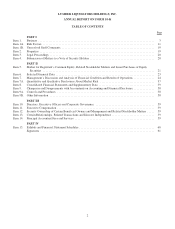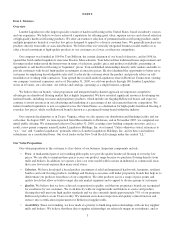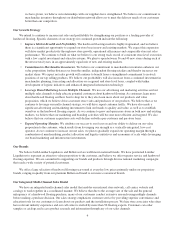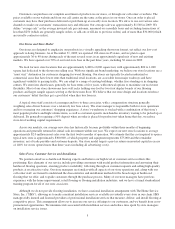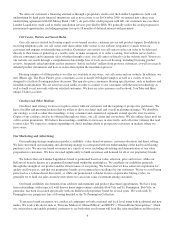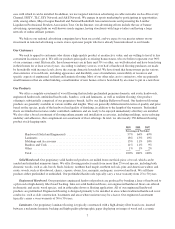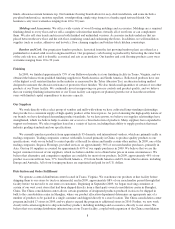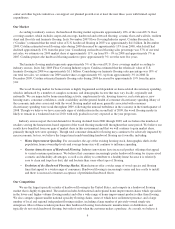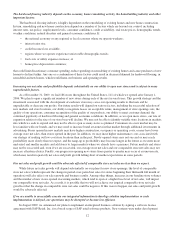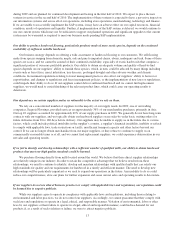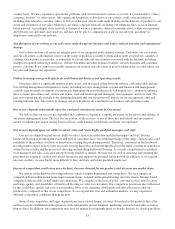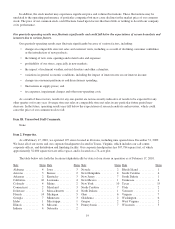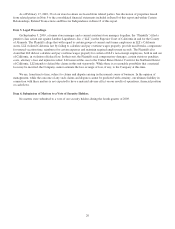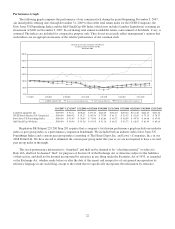Lumber Liquidators 2009 Annual Report Download - page 18
Download and view the complete annual report
Please find page 18 of the 2009 Lumber Liquidators annual report below. You can navigate through the pages in the report by either clicking on the pages listed below, or by using the keyword search tool below to find specific information within the annual report.The hardwood flooring industry depends on the economy, home remodeling activity, the homebuilding industry and other
important factors.
The hardwood flooring industry is highly dependent on the remodeling of existing homes and new home construction.
In turn, remodeling and new home construction depend on a number of factors which are beyond our control, including
interest rates, tax policy, employment levels, consumer confidence, credit availability, real estate prices, demographic trends,
weather conditions, natural disasters and general economic conditions. If:
• the national economy or any regional or local economy where we operate weakens;
• interest rates rise;
• credit becomes less available;
• regions where we operate experience unfavorable demographic trends;
• fuel costs or utility expenses increase; or
• home-price depreciation continues;
that could limit discretionary consumer spending, reduce spending on remodeling of existing homes and cause purchases of new
homes to decline further. Any one or a combination of these factors could result in decreased demand for hardwood flooring, in
remodeled and new homes, which would harm our business and operating results.
Increasing our net sales and profitability depends substantially on our ability to open new stores and is subject to many
unpredictable factors.
As of December 31, 2009, we had 186 stores throughout the United States, 111 of which we opened after January 1,
2006. We plan to open a significant number of new stores during each of the next several years. This growth strategy and the
investment associated with the development of each new store may cause our operating results to fluctuate and be
unpredictable or decrease our profits. Our future results will depend on various factors, including the successful selection of
new markets and store locations, our ability to negotiate leases on acceptable terms, management of store opening costs, the
quality of our operations, consumer recognition of the quality of our products, our ability to meet customer demand, the
continued popularity of hardwood flooring and general economic conditions. In addition, as we open more stores, our rate of
expansion relative to the size of our store base will decline. We may not be able to identify suitable store locations in markets
into which we seek to expand and may not be able to open as many stores as planned. Consumers in a new market may be
less familiar with our brands, and we may need to increase brand awareness in that market through additional investments in
advertising. Stores opened in new markets may have higher construction, occupancy or operating costs, or may have lower
average store net sales, than stores opened in the past. In addition, we may incur higher maintenance costs associated with
our strategy of seeking out low-cost store locations than in the past. Newly opened stores may not succeed or may reach
profitability more slowly than we expect, and the ramp-up to profitability may become longer in the future as we enter more
mid-sized and smaller markets and add stores to larger markets where we already have a presence. Future markets and stores
may not be successful and, even if we are successful, our average store net sales and our comparable store net sales may not
increase at historical rates. Finally, our progress in opening new stores from quarter to quarter may occur at an uneven rate,
which may result in quarterly net sales and profit growth falling short of market expectations in some periods.
Our net sales and profit growth could be adversely affected if comparable store net sales are less than we expect.
While future net sales growth will depend substantially on our plans for new store openings, the level of comparable
store net sales (which represent the change in period-over-period net sales for stores beginning their thirteenth full month of
operation) will also affect our sales growth and business results. Among other things, increases in our baseline store volumes
and the number of new stores opened in existing markets, which tend to open at a higher base level of net sales, will impact
our comparable store net sales. As a result, it is possible that we will not achieve our targeted comparable store net sales
growth or that the change in comparable store net sales could be negative. If this were to happen, net sales and profit growth
would be adversely affected.
If we are unable to successfully execute our integrated information technology solution implementation or such
implementation is delayed, our operations may be disrupted or become less efficient.
In August 2009, we announced our plans to implement an integrated business solution by signing a software license
agreement with SAP Retail, Inc. for a broad scope of SAP retail software products. New systems were under development
12


